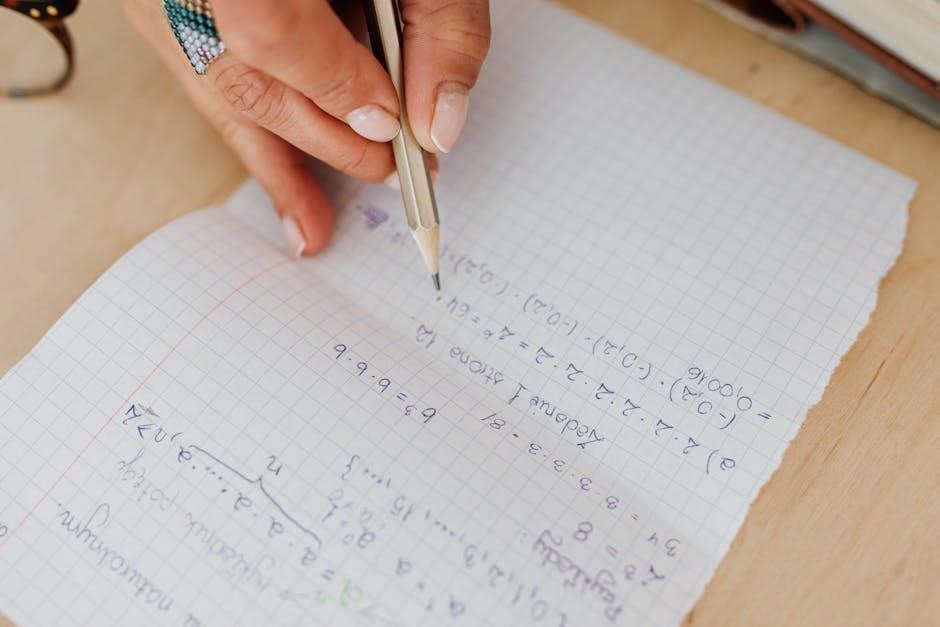Solving systems of equations is a fundamental skill in algebra, essential for understanding relationships between variables. This section introduces key methods and strategies for finding solutions effectively.
1.1 Importance of Systems of Equations in Algebra
Solving systems of equations is crucial in algebra as it models real-world problems involving multiple variables. It enhances problem-solving skills, logical reasoning, and analytical thinking. Mastery of this concept is essential for advanced math, science, and engineering, enabling the solution of complex scenarios like resource allocation and financial planning. Proficiency in systems of equations fosters a deeper understanding of variable relationships and their practical applications.
1.2 Brief Overview of Methods to Solve Systems of Equations
Systems of equations can be solved using three primary methods: graphing, substitution, and elimination. Graphing involves plotting equations to find their intersection point. Substitution requires solving one equation for a variable and substituting it into the other. Elimination involves manipulating equations to eliminate one variable. Each method offers unique advantages, with substitution and elimination being algebraic approaches suitable for linear systems, while graphing provides a visual solution, ideal for understanding relationships between variables.

Solving Systems of Equations by Graphing
Graphing systems of equations involves plotting both equations on a coordinate plane and identifying their intersection point, which represents the solution. This visual method is effective for understanding how equations relate and for verifying solutions, especially when the solution is a simple integer pair. It provides a clear, intuitive approach to seeing how variables interact within the system.
2.1 Step-by-Step Guide to Graphing Systems
Write both equations in slope-intercept form (y = mx + b) for easier graphing. Identify the slope and y-intercept for each equation. Plot the y-intercept on the graph. Use the slope to mark equal intervals, ensuring accuracy. Draw a straight line through the plotted points for each equation. Locate the point where the two lines intersect; this is the solution. Verify by plugging the coordinates back into both original equations to ensure consistency. This method provides a clear visual confirmation of the system’s solution, making it ideal for identifying dependent and independent systems. It is particularly useful for educational purposes as it helps students understand the geometric interpretation of algebraic solutions.
2.2 Examples of Solving Systems by Graphing
For example, solve the system:
( y = 2x ─ 7 )
( y = -3x + 4 )
Graph both equations on the same coordinate plane. Plot the y-intercepts (-7 and 4) and use the slopes (2 and -3) to draw the lines. The intersection point, where the lines cross, is the solution. In this case, the solution is ( (1, -5) ). This method provides a visual representation, making it easier to identify the solution accurately and verify it by substitution. It is particularly useful for educational purposes, as it helps students understand the relationship between equations graphically.
2.3 Checking Solutions on a Graph
After identifying the intersection point of two lines, verify the solution by plugging the coordinates back into both original equations. For example, if the intersection is (4, 5), substitute x = 4 and y = 5 into each equation to ensure equality holds. This step confirms the accuracy of the solution. Graphing also provides a visual confirmation, allowing users to see if the point lies correctly on both lines, reinforcing their understanding of the system’s behavior and solution validity.

Solving Systems of Equations by Substitution
The substitution method involves solving one equation for a variable and substituting it into the other equation to find the solution. This approach is efficient when one equation is easily solvable for a variable, allowing straightforward substitution and simplification to find the solution.
3.1 Step-by-Step Guide to the Substitution Method
Choose one equation and solve for one variable in terms of the other.
Substitute this expression into the second equation;
Solve the resulting equation for the remaining variable.
Use this value to find the first variable.
Present the solution as an ordered pair.
This method is ideal when one equation is easily solvable for a variable, streamlining the process of finding the system’s solution.
3.2 Examples of Solving Systems by Substitution
Example 1: Solve the system:
y = 6x ー 11
-2x ─ 3y = -7
Substitute y = 6x ─ 11 into the second equation:
-2x ─ 3(6x ー 11) = -7
Simplify and solve for x, then find y.
Example 2: Solve the system:
2x ─ 3y = -1
y = x ─ 1
Substitute y = x ー 1 into the first equation:
2x ─ 3(x ─ 1) = -1
Simplify and solve for x, then find y.
These examples demonstrate how substitution simplifies solving systems of equations by reducing them to a single variable.
3.3 Common Errors and Tips for Accuracy
Common errors in substitution include incorrect substitution and algebraic mistakes. Ensure all terms are distributed properly and like terms combined. Double-check signs and coefficients during substitution. Verify solutions by plugging them back into original equations. Use worksheets with answer keys to identify and correct mistakes, enhancing accuracy and understanding of the substitution method.

Solving Systems of Equations by Elimination
The elimination method is a powerful technique for solving systems of equations by eliminating variables to simplify the system. It is particularly effective for linear systems.
4.1 Step-by-Step Guide to the Elimination Method
To solve a system using elimination, start by ensuring both equations are in standard form. Next, make the coefficients of one variable equal by multiplying equations if needed. Subtract or add the equations to eliminate the variable. Solve for the remaining variable and substitute back to find the other. Check the solution by plugging values into the original equations to ensure accuracy.
4.2 Examples of Solving Systems by Elimination
Example 1: Solve the system:
4x ー 2y = 12
4x + 8y = -24
Subtract the first equation from the second:
(4x + 8y) ー (4x ─ 2y) = -24 ─ 12
10y = -36
y = -3.6
Substitute y back into the first equation:
4x ー 2(-3.6) = 12
4x + 7.2 = 12
4x = 4.8
x = 1.2
Solution: (1.2, -3.6).
Example 2:
x ー y = 11
2x + y = 19
Add both equations:
3x = 30
x = 10
Substitute x back:
10 ─ y = 11
y = -1
Solution: (10, -1).
Special cases may result in no solution or infinite solutions.
4.3 Special Cases: No Solution or Infinite Solutions
In some systems, equations may be parallel or identical, leading to special cases. If the coefficients of x and y are proportional but the constants are not, the system has no solution (e.g., 4x ー 2y = 12 and 4x + 8y = -24). Conversely, if both equations are identical, the system has infinite solutions (e.g., x ー y = 11 and 2x ー 2y = 22). These cases require careful analysis to determine the solution set.
Real-World Applications of Solving Systems of Equations
Systems of equations are crucial for solving real-world problems, such as financial planning and resource management, as seen in examples involving money and budgeting.
5.1 Examples of Word Problems Involving Systems
Systems of equations are applied to real-world scenarios, such as budgeting, resource allocation, and financial planning. For instance, problems involving money, like Sarah’s piggy bank with quarters and dimes, or a jar containing coins, demonstrate how systems can solve practical issues. These word problems often require setting up equations based on given conditions and solving them to find unknown quantities, making the concept highly relevant and useful in everyday life.
5.2 Solving Financial and Resource Allocation Problems
Financial and resource allocation problems often involve systems of equations to manage budgets, investments, and distributions. For example, determining the number of quarters and dimes in a jar or allocating resources between different projects can be efficiently solved using systems. By setting up equations based on total amounts and ratios, individuals can find optimal solutions, ensuring efficient use of resources and achieving financial goals effectively.

Tips for Finding the Correct Answer Key
Verify solutions by plugging values back into original equations. Check for calculation errors and ensure all steps are logical. Use answer keys wisely to identify mistakes and improve accuracy.
6.1 Verifying Solutions in the Answer Key
Verifying solutions ensures accuracy and understanding. Substitute the answer key values back into original equations to confirm they satisfy both equations. Check for calculation consistency and logical steps. Use online tools or step-by-step guides to cross-validate solutions. This process helps identify errors and strengthens problem-solving skills, ensuring reliable results for systems of equations worksheets.
6.2 Understanding Common Mistakes in Solutions
Identifying common errors is crucial for improving accuracy. Mistakes like arithmetic miscalculations, incorrect substitution, or misapplying elimination methods often lead to wrong solutions. Reviewing answer keys helps spot these errors. Pay attention to sign mistakes and ensure all steps are logically consistent. Learning from these oversights enhances problem-solving techniques and builds confidence in tackling complex systems of equations effectively in the future.
Practice Worksheets and Answer Keys
Utilize practice worksheets to enhance problem-solving skills. Answer keys provide feedback, ensuring accuracy and understanding. Regular practice with these tools improves logical thinking and mathematical precision effectively.
7.1 Recommended Worksheets for Practice
Engage with worksheets that cover graphing, substitution, and elimination methods. Mixed-method worksheets enhance adaptability. Word problem sheets apply concepts to real-world scenarios, strengthening practical understanding. Worksheets with answer keys allow self-assessment, fostering independent learning. Select resources with clear instructions and varied difficulty levels to cater to different skill levels, ensuring comprehensive practice and mastery of solving systems of equations.
7.2 How to Use Answer Keys Effectively
Answer keys are invaluable for self-assessment and understanding mistakes; Compare your solutions with the provided answers to verify accuracy. Detailed solutions help identify errors in methods like substitution or elimination. Use them to refine techniques and improve problem-solving skills. Regularly reviewing answer keys enhances learning and ensures mastery of systems of equations.

Creating Your Own Systems of Equations Worksheets
Designing custom worksheets allows tailored practice for students. Include varied difficulty levels and real-world applications. Ensure answer keys are accurate for self-assessment and learning.
8.1 Designing Problems with Varied Difficulty
When creating worksheets, include problems ranging from basic to complex. Start with simple systems for beginners, then introduce challenges like no solution or infinite solutions. Incorporate word problems and real-world scenarios to enhance understanding and application. Ensure each problem set progresses logically, allowing students to build confidence and skills gradually. This approach promotes a comprehensive grasp of systems of equations.
8.2 Ensuring Accuracy in Answer Keys
Accuracy in answer keys is crucial for student assessment and learning. Double-check each solution using multiple methods, such as substitution and elimination. Cross-verify answers with original equations to ensure correctness. Highlight potential errors and provide clear explanations. Regularly update answer keys to reflect feedback and maintain consistency across all problems. This ensures reliability and builds student trust in the educational materials provided.
Mastering systems of equations is vital for algebra proficiency. Worksheets and answer keys provide structured practice, ensuring understanding and accuracy. Continuous practice fosters problem-solving skills and confidence.
9.1 Summary of Key Concepts
Solving systems of equations involves graphing, substitution, and elimination methods. Each technique requires precise algebraic manipulation to find accurate solutions. Real-world applications, such as financial planning and resource allocation, demonstrate the practical value of these skills. Worksheets and answer keys provide structured practice, ensuring mastery and confidence in solving complex problems. Regular practice reinforces understanding and improves problem-solving abilities, making these concepts indispensable in algebra and beyond.
9.2 Encouragement for Further Practice
Continuous practice is key to mastering systems of equations. Use worksheets and answer keys to refine your skills in graphing, substitution, and elimination. Challenge yourself with varied problems to enhance problem-solving abilities. Regular review strengthens understanding and builds confidence. Embrace difficult questions as opportunities to grow, ensuring long-term success in algebra and its applications.


0 Comments